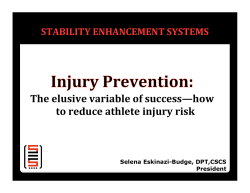
The Female Athlete Triad
SP ORTS ME DICIN E The Female Athlete Triad ELIZABETH HORN, MD; NICOLE GERGEN, MD; KELLY A. M C GARRY, MD, FACP A BST RA C T The female athlete triad is a spectrum of interrelated pathophysiologic consequences of low energy availability, menstrual dysfunction, and low bone mineral density. Components of the triad are not only counterproductive to athletic performance goals, but can lead to serious longterm negative health outcomes. Practitioners caring for female athletes play an important role detecting at-risk athletes early in their course along the disease spectrum. Importantly, women who are evaluated for one component of the triad should always be screened for the other two. Detecting the disorder early is the most important factor for preventing the potentially severe consequences, and requires heightened vigilance on the part of all those who work with this special patient population. In this article, we discuss the epidemiology, pathophysiology, diagnosis, evaluation, and management of the female athlete triad. K E YWORD S: female athlete triad, menstrual dysfunction, disordered eating, altered bone density INTRO D U C T I O N Female involvement in athletics and exercise has increased over recent decades. While exercise is encouraged for general health and disease prevention, female athletes are susceptible to negative health outcomes if energy balance is not maintained. Physicians should be familiar with the female athlete triad to enable proper evaluation, diagnosis, and management of the disorder. DEF I N I T I O N The female athlete triad is a spectrum of disease encompassing a broad set of disorders involving low energy availability, menstrual dysfunction, and low bone mineral density (BMD). First identified by the American College of Sports Medicine (ACSM) in 1992, the triad was initially characterized by disordered eating, amenorrhea, and osteoporosis. Since then, the nosology has been modified to reflect the disease continuum. The current definition reflects variable manifestations within each component of the triad. For example, negative energy balance can occur in athletes with W W W. R I M E D . O R G | RIMJ ARCHIVES | N O V E M B E R W E B PA G E average caloric intake but excessive energy expenditure, or in those with eating disorders. Menstrual dysfunction includes primary amenorrhea, secondary amenorrhea, and oligomenorrhea. Low BMD may manifest as an asymptomatic finding on dual-energy X-ray absorptiometry (DEXA) scan, stress fractures, or pathologic fractures. Fundamentally, the female athlete triad is a spectrum of three distinct pathophysiologic states with varied presentations. EP ID EMIOLOGY A recent review examining young women ages 17–25 years old who exercise suggested that the prevalence of all three components of the disorder ranged between 0-15.9%.1 The wide prevalence estimates are due to several factors, including the changing definition of the female athlete triad, variance in prevalence between types of athletes, as well as inherent diagnostic challenges. It is uncommon for all components of the triad to be diagnosed in concert. Rather, women afflicted with the female athlete triad evolve symptoms and features of the syndrome along non-congruent disease continuums for each component of the triad. Women participating in “lean sports” which assign aesthetic value to performance including gymnastics, ballet dancing, and ice skating are at higher risk for developing the female athlete triad. Studies comparing lean-sport athletes versus nonlean sport athletes demonstrated a prevalence of all three components of the female athlete triad in up to 6.7% of leansport athletes compared to 2.0% of non-lean sport athletes.1 Epidemiological data exist for components of the female athlete triad. Negative energy balance is the primary disorder in the female athlete triad driving menstrual dysregulation and low BMD. Low energy availability can occur in the setting of both caloric restriction and excessive exercise. In the general adolescent female population, the prevalence of disordered eating is estimated between 13-20%.2,3 By contrast, between 15% and 62% of female high school and college athletes exhibit disordered eating, but it is unclear how many have clinical eating disorders or low energy availability leading to triad sequelae. Menstrual dysfunction manifesting as secondary amenorrhea is reported as high as 69% prevalence in female athletes who participate in lean sports compared with 5% of the general population.4 The prevalence of low BMD is difficult to define in the female athlete population as most young women are not candidates NOVEMBER 2014 RHODE ISLAND MEDICAL JOURNAL 18 SP ORTS ME DICIN E for BMD testing. Some studies estimate the prevalence of low bone density in female athletes is as high as 13% compared to 2.3% in the general adult population.4 Despite lack of epidemiologic clarity, the association between these three disorders is well established, meriting evaluation of all components of the triad when one disorder is identified. Pathophysiology: Low Energy Availability Low energy availability, defined as insufficient energy to supply metabolic demand, is the primary disorder driving pathophysiologic changes in the female athlete triad. Negative energy balance results in insufficient metabolic supply for normal menstrual function, bone development, and bone maintenance. Factors dictating energy availability include caloric intake, baseline metabolic function, and energy expenditure. Female athletes may maintain adequate nutrition for average caloric requirements but rigorous training demands contribute to caloric deficit. Alternatively, maladaptive dietary habits such as restriction, purging, laxative, stimulant and diuretic use may lead to insufficient energy availability. When evaluating the female athlete triad, it is important to distinguish between excessive energy expenditure for caloric intake, disordered eating, and a clinically defined eating disorder, the latter of which would necessitate psychiatric evaluation. ACSM Information On… The Female Athlete Triad The Female Athlete Triad is a health concern for active women and girls who are driven to excel in sports. It involves three distinct and interrelated conditions: disordered eating (a range of poor nutritional behaviors), amenorrhea (irregular or absent menstrual periods) and osteoporosis (low bone mass and microarchitectural deterioration, which leads to weak bones and risk of fracture). A COMPLETE PHYSICAL ACTIVITY PROGRAM A well-rounded physical activity program includes aerobic exercise and strength training exercise, but not necessarily in the same session. This blend helps maintain or improve cardiorespiratory and muscular fitness and overall health and function. Regular physical activity will provide more health benefits than sporadic, high intensity workouts, so choose exercises you are likely to enjoy and that you can incorporate into your schedule. ACSM’s physical activity recommendations for healthy adults, updated in 2011, recommend at least 30 minutes of moderate-intensity physical activity (working hard enough to break a sweat, but still able to carry on a conversation) five days per week, or 20 minutes of more vigorous activity three days per week. Combinations of moderate- and vigorousintensity activity can be performed to meet this recommendation. FEMALE ATHLETE TRIAD CAUSES Exercise alone does not put someone at risk for developing the Triad; however, an energy deficit, in which caloric intake doesn’t match energy expenditure, is a risk factor. All women face societal pressure that “thin is in.” A young woman or girl who is determined to achieve a lean appearance or athletic success may attempt to excel through compulsive dieting and exercise. (Such athletes are typically goal-oriented perfectionists.) This misguided approach may lead to disordered eating, menstrual dysfunction and lower-than-normal bone mass formation. WHO IS AFFECTED? Examples of typical aerobic exercises are: • Walking • Running • Stair climbing • Cycling • Rowing • Cross country skiing • Swimming. In addition, strength training should be performed a minimum of two days each week, with 8-12 repetitions of 8-10 different exercises that target all major muscle groups. This type of training can be accomplished using body weight, resistance bands, free weights, medicine balls or weight machines. Anyone may be affected, but women and girls participating in activities which emphasize leanness are at especially high risk. These activities can include: • Gymnastics • Ballet • Diving • Figure skating • Aerobics • Running Weight class sports associated with disordered eating in athletes, including males, are: • Wrestling • Rowing • Martial arts DISORDERED EATING In response to pressure to lose weight, women and girls may practice unhealthy weight-control methods, including restricted food intake, self-induced vomiting, consumption of appetite suppressants and diet pills, and use of laxatives and compounds to increase urination. Specific eating disorders are anorexia nervosa and bulimia. Many girls and women hide or deny their eating disorders due to embarrassment, shame, fear of losing control of their dieting and a mistaken believe that excessive weight loss enhances performance. | RIMJ ARCHIVES | Menstrual dysfunction may present as primary amenorrhea, secondary amenorrhea, or oligomenorrhea. Primary amenorrhea is the absence of menses at age 15 in the presence of normal growth and secondary sexual characteristics or the absence of menses three years after development of secondary sexual characteristics. Secondary amenorrhea is the absence of menses for more than three cycles or six months in women who previously had regular menses, or the absence of menses for more than nine months in women who previously had irregular menses. Oligomenorrhea is defined as menstrual cycles >35 days apart. Because eumenorrhea may not be established until late in adolescence or early adulthood, menstrual dysfunction may be difficult to establish. When a female athlete develops negative energy balance and subsequent hypometabolic state, hypothalamic GnRH pulsatility is altered.5 Hypothalamic dysfunction leads to anovulation and subsequent menstrual disturbances.6 Pathophysiology: Altered Bone Mineral Density Bone health is maintained through a continuous process of balanced osteoblastic and osteoclastic activity. In females with a negative energy balance, altered GnRH pulsatility suppresses the hypothalamic-pituitary axis and results in a hypoestrogenic state. In healthy menstruating females, estrogen suppresses osteoclastic activity, promoting bone development and normal BMD. Thus, low BMD in women with the female athlete triad is secondary to the lack of adequate estrogen supply for optimal bone health. Women with menstrual dysfunction and low estrogen can lose up to 2% of BMD annually.7 Rigorous athletic activity alters the development and maintenance of bone health in preferential anatomic locations.8 In female athletes, sport activity may increase density of weight bearing bones such as the femur while other bones, including the spine may demonstrate altered BMD. Pathologic and stress fractures should prompt clinical evaluation for the female athlete triad. D IA GNOSTIC EVA LU ATION: THE F EMA LE ATHLETE TRIA D Primary care providers play an integral role in the diagnosis of the triad. Identifying at-risk athletes optimally occurs during academic and sports related screenings or in the setting of office visits for menstrual dysfunction, pathologic or stress fractures or disordered eating. Ideally, parents and athletic trainers should be able to recognize components of the female athlete triad and its negative health consequences. WARNING SIGNS OF EATING DISORDERS • Excessive leanness or rapid weight loss; • Preoccupation with weight, food, mealtime rituals and body image; • Avoiding team meals, or secretive eating; • Wide fluctuations in weight; Reprinted with permission of the American College of Sports Medicine. Copyright © 2011 American College of Sports Medicine. http://www.acsm.org/docs/brochures/the-female-athlete-triad.pdf W W W. R I M E D . O R G Pathophysiology: Menstrual Dysfunction N O V E M B E R W E B PA G E Assessing Low Energy Availability Evaluation of energy state is essential in evaluating a patient for the female athlete triad. Important historical aspects include dietary habits (current and past), highest and lowest weight, and perception of ideal body weight. Patients should be assessed for disordered eating including restriction, NOVEMBER 2014 RHODE ISLAND MEDICAL JOURNAL 19 SP ORTS ME DICIN E purging, and use of diuretics, laxatives, or stimulants. Activity level should be determined by evaluating duration and intensity of daily exercise and sports involvement. Examination should include measurement of orthostatic vital signs assessing for resting tachycardia and volume depletion, weight, and BMI. It is important to note findings suggestive of eating disorders including lanugo, parotid gland enlargement, dental enamel erosions and knuckle calluses caused by self-induced vomiting. Laboratory evaluation should include complete blood counts, complete metabolic profile, thyroid function tests and urinalysis. If electrolyte abnormalities are present or the patient presents with bradycardia, an EKG should be performed to assess for arrhythmia or prolonged QT interval. Menstrual Dysfunction The ACSM recommends screening for the triad in any female athlete with a total of six months of amenorrhea or oligomenorrhea.9 When evaluating a patient for menstrual dysfunction, providers should ask about age at menarche, frequency and duration of menstrual cycles, last menstrual period, and medication use including oral contraceptives. Careful examination of the patient with a focus on secondary sexual characteristics, signs of hyperandrogenism or findings suggestive of thyroid dysfunction may help distinguish other causes of menstrual dysfunction from altered GnRH pulsatility seen in the female athlete triad. The first step in laboratory evaluation is a pregnancy test. Subsequent work up may include evaluation for polycystic ovarian syndrome, thyroid or pituitary abnormalities. Drugs which affect the menstrual cycle such as contraceptives, antipsychotics or thyroid medications should be identified. Depending on the clinical scenario, evaluation of follicle stimulating hormone (FSH), leutinizing hormone (LH) and possibly MRI evaluation for a pituitary process may be indicated. Importantly, hypothalamic amenorrhea due to decreased GnRH pulsatility seen in the female athlete triad is a diagnosis of exclusion.5 Altered Bone Mineral Density Altered BMD may present as abnormal bone development, osteopenia, and osteoporosis. Initial evaluation should include obtaining a history of stress fractures, overuse injuries, and pathologic fractures. A careful assessment of ovulatory status should be performed. The evaluation of BMD can be difficult in the female athlete given continued bone development in adolescence. Osteoporosis can be evaluated with DEXA scanning using the T-score or the Z-score. The T-score compares BMD to a thirty year old adult control whereas the Z-score compares BMD to age and gender matched controls. The latter is a more appropriate diagnostic method for female athletes who have yet to achieve maximum bone density. Evaluation of osteoporosis in the young female athlete is further complicated by site dependent alteration in BMD as discussed previously. W W W. R I M E D . O R G | RIMJ ARCHIVES | N O V E M B E R W E B PA G E TREATMENT C ONSID ERATIONS Low Energy State Due to increased caloric requirements of female athletes, nutritional support and dietary counseling are integral to the treatment of these patients, regardless of the presence or absence of disordered eating. The ACSM recommends establishing weight goals in writing in order to continue athletic participation.9 Realistic training goals should be identified. Additionally, the organization recommends a nutrition education program, stress reduction, and consideration of bone densitometry screening. If there is concern for an eating disorder, referral to a mental health specialist is appropriate. Menstrual Dysfunction While a weight or energy requirement goal for the resumption of eumenorrhea has not been definitively established, one study found that restoration of eumenorrhea in anorexia nervosa patients required weight gain of 2 kilograms over the weight at which secondary amenorrhea occurred.10 Patients who wish to become pregnant require special consideration. While normalization of menstrual cycle and ovulation can be attained by increasing energy availability, weight gain, and subsequent normal pulsatile GnRH activity, other endocrinologic interventions are available and may be necessary but are beyond the scope of this article. Altered Bone Mineral Density The ACSM recommends consideration of DEXA screening in at risk patients.9 Resolving the low-energy state is the optimal treatment for altered BMD. A variety of therapies have been proposed. Bisphosphonates are used for the treatment of osteoporosis in post-menopausal women and have been considered in this disorder. Their effectiveness has yet to be demonstrated in premenopausal women. Human trials have not established bisphosphonate teratogenicity but animal trials have shown adverse effects on the fetus. A reasonable pharmacologic approach to bone health supplementation in the female athlete includes vitamin D (400–1000 IU/day) and calcium (1300 mg/day).9 F U TU RE RESEA RC H Future directions will include a focus on examining the role of hormone replacement in re-establishment of menstruation and normal BMD. Oral contraceptive pills have been used to treat adolescents with menstrual dysfunction from other causes, but their use has not been adequately studied in the female athlete population. Initial data in female athletes is mixed with respect to the effect of oral contraceptive pills on bone health.11 Transdermal estrogen is also an emerging area of research interest. It is thought that transdermal preparations of estrogen may be preferable to oral contraceptive pills in that they have less of an inhibitory effect on insulin-like growth factor-1, a trophic hormone that has been shown to promote bone formation.4,12 In NOVEMBER 2014 RHODE ISLAND MEDICAL JOURNAL 20 SP ORTS ME DICIN E postmenopausal women, transdermal estrogen has reduced fracture risk, but its potential benefits and harms have not been well studied in the young female athlete population. References 1. Gibbs JC, Williams NL, De Souza MJ. Prevalence of individual and combined components of the female athlete triad. Med Sci Sports Exerc. 2012; epub ahead of print. 2. Johnson C, Powers PS, Dick R. Athletes and eating disorders: the National Collegiate Athletic Association study. Int J Eating Disord. 1999; 26:179-188. 3. Beals KA, Manore II. Disorders of the female athlete triad among collegiate athletes. Int J Sports Nutr Exerc Metab. 2002;12:281293. 4. Nazem TG, Ackerman KE. The Female Athlete Triad. Sports Health. 2012;4:302. 5. Warren MP, Perlroth NE. The effects of intense exercise on the female reproductive system. Journal of Endocrinology. 2001;170:3-11. 6. Williams NI, Helmreich DL, Parfitt DB, et al. Evidence for a causal role of low energy availability in the induction of menstrual cycle disturbances during strenuous exercise training. J Clin Endocrinol Metab. 2001;86:5184-5193. 7. Deimel JF, Dunlap BJ. The female athlete triad. Clin Sports Med. 2012;31:247-254. 8. Cobb KL, Bachrach LK, Greendale G, et al. Disordered eating, menstrual irregularity, and bone mineral density in female runners. Med Sci Sports Exerc. 2002;711-719. 9. Nattiv A, Loucks AB, Manore MM, Sanborn CF, Sundgot-Borgen J, Warren MP. American College of Sports Medicine position stand: the female athlete triad. Med Sci Sports Exerc. 2007;30:1867-1882. 10.Golden NH, Jacobson MS, Sterling WM, Hertz S. Treatment goal weight in adolescents with anorexia nervosa: use of BMI percentiles. Int J Eat Disord. 2008;41:301-306. 11.Liu SL, Lebrun CM. Effect of oral contraceptives and hormone replacement therapy on BMD in premenopausal and perimenopausal women: a systematic review. Br J Sports Med. 2006;40:1124. 12.Grinspoon S, Baum H, Lee K, Anderson E, Herzog D, Klibanski A. Effects of a short-term recombinant human insulin-like growth factor I administration on bone turnover in osteopenic women with anorexia nervosa. Journal of Clinical Endocrinology and Metabolism. 1996;31:3864-3870. 13. Joy EA, Van Hala S, Cooper L. Health-related concerns of the female athlete: a lifespan approach. American Family Physician. 2007;79(6):489-495. W W W. R I M E D . O R G | RIMJ ARCHIVES | N O V E M B E R W E B PA G E Authors Elizabeth Horn, MD, is a Housestaff Officer, Internal Medicine, The Alpert Medical School of Brown University. Nicole Gergen, MD, is a Housestaff Officer, Internal MedicinePediatrics, The Alpert Medical School of Brown University. Kelly A. McGarry, MD, FACP, is Associate Professor of Medicine, The Alpert Medical School of Brown University and Program Director, General Internal Medicine Residency, Rhode Island Hospital, Providence, RI. Correspondence Kelly A. McGarry, MD Rhode Island Hospital 593 Eddy Street Providence, RI 02903 401-444-5953 Fax 401-444-3056 kmcgarry@lifespan.org NOVEMBER 2014 RHODE ISLAND MEDICAL JOURNAL 21
© Copyright 2025









